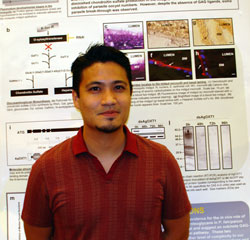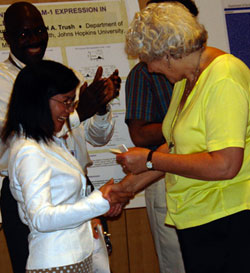Second Annual Poster Competition for Postdoctoral Fellows (web article)

Rhoel Dinglasan, PhD, MPH, even though he knows that all scientific discoveries contribute to the overall expansion of knowledge, isn’t interested in just carving out a comfortable research niche for himself. “I hope my research actually makes a difference, in an applied sense,” he says.
One indication that Dinglasan, a postdoctoral fellow in Molecular Microbiology and Immunology, might be on the right track: a poster illustrating his strategy for blocking the Plasmodium parasite’s entry into the mosquito midgut won first prize at the Bloomberg School’s July 19-20 Annual Poster Competition for Postdoctoral Fellows.
The annual poster session, now in its second year, is one of the events Sharon Krag, PhD, has organized to get the School’s 150 postdocs out of their laboratories and offices and away from their samples and computers. At the presentation of the winning posters, she said, “One concern of mine has been to build a community [among the postdocs] because it’s so easy to end up isolated in one’s research.”
The posters’ topics covered a wide range of research interests, from evaluating how a community-based arts program affected its school-age participants, to examining some of the molecular processes that Plasmodium uses to infest the mosquito.
In her remarks, Krag, a professor of Biochemistry and Molecular Biology and the School’s associate dean of Graduate Education and Research, said that the four faculty members who judged the posters (she’s the only one who has admitted to being a judge) “were impressed by the diversity of the science that’s going on at this School?lab-based, quantitative-based and qualitative-based work.”
The judges were also impressed by the quality of the work. “After 1½ hours of deliberating,” said Krag, “the judges easily decided on the first and second places, but we couldn’t decide on a third-place winner. So, we’ve chosen to award four honorable-mention winners, all of whom will receive the $500 third-place prize.”
The Winners
1st place ($1,500)
Rhoel Dinglasan, PhD, MPH, Molecular Microbiology and Immunology. Chondroitin Sulfate Proteoglycans Mediate Plasmodium Falciparum Ookinete Invasion of the Mosquito Midgut.
Over the past year, Dinglasan discovered the first evidence that glycosaminoglycans in the mosquito midgut are potential receptors for the Plasmodium parasite; that is, they allow the parasite to invade the midgut. In his previous work, he used an antibody against an oligosaccharide that could completely block parasite development in the mosquito. Shutting down chondroitin sulfate proteoglycans inhibits parasite invasion by over 90 percent, thus showing that the proteoglycans represent critical adhesion receptors for Plasmodium ookinetes. He hopes to determine the exact structure of the chondroitin sulfate chain so as to use it as a vaccine antigen to generate antibodies in humans that, when taken up by the mosquito during feeding, will stop parasite development in its tracks.
2nd place ($1,000)

Xiaoli Chen accepts her award from Sharon Krag (right)
Xiaoli Chen, MD, PhD, International Health, Center for Human Nutrition. The Influence of Obesity on Risk and Outcomes of Kidney Disease: A Systematic Review and Meta-analysis.
Few systematic analyses have been conducted on the association between obesity and kidney disease. Xiaoli Chen and her colleagues conducted a meta-analysis of findings from 18 cohort studies in the general population and found that, compared with normal-weight individuals, overweight persons had a 40 percent greater risk for kidney disease, and obese people an 83 percent greater risk.
Honorable Mention ($500 each)
- Rajesh Thimmulappa, PhD, Environmental Health Sciences. Nrf2: A Critical Host Factor in Regulating Innate Immune Response and Protecting from Sepsis Syndrome. Sepsis is a complex disease in which the body’s immune system mounts a too-vigorous response to an infection, thus damaging tissue and causing multiple organ failure or death. Thimmulappa and colleagues found that the deletion of the Nrf2 gene enhanced this destructive inflammatory response, and are now trying to determine if activating Nrf2 by using a small-molecule drug will minimize the damage caused by sepsis.
- Brian Cornblatt, PhD, Environmental Health Sciences. Mechanistic Underpinnings to Chemoprevention of Breast Cancer with Sulforaphane. A compound found in broccoli, sulforaphane, is known to prevent breast tumors in animals—but can it do the same in humans? Working with animal models, Cornblatt and his colleagues were able to uncover novel molecular clues of this tumor-blocking action. Now they’ve shown that if a woman ingests preparation containing sulforaphane by mouth, the compound is indeed delivered to the tissues of the breast. They are translationally applying their discoveries and seeking to uncover whether this compound enhances the expression of protective genes in the breast tissue of women?in science-speak, they are establishing “proof of principal,” the first step in mounting a clinical trial.
- Dr. Girish Hiremath, MD, MPH, International Health. Childhood Malnutrition, and Relationship with Infections, and Poverty: A New Perspective. The conventional method of determining the burden of malnutrition and for setting targets for Millennium Development Goals (MDG) in developing countries is to determine the prevalence of underweight children in that country. The underweight index, however, is prone to variability and inaccuracies. Hiremath and his colleagues found that, compared to the Composite Index of Anthropometric Failure (CIAF), the underweight index failed to identify 8 percent to 17 percent of children in anthropometrically failed states. Hiremath and his colleagues have validated that CIAF and Disaggregated Anthropometric Indices (DI) are better markers of true nutritional failure at the country or regional level, and show a strong association with infection and poverty. Hiremath and his colleagues thus suggest that CIAF and DI be considered as a replacement of underweight for evaluation of the burden of malnutrition and tracking of MDGs.
- Elizabeth Selvin, PhD, MPH, Epidemiology. Prevalence and Risk Factors for Erectile Dysfunction in the U.S. The 18 million American men who have erectile dysfunction (ED) are at greater risk of heart disease and diabetes, according to Elizabeth Selvin and colleagues. The researchers have found a strong link between cardiovascular risk factors and ED but hope their findings—especially that increasing exercise levels may prevent ED—will motivate men to make healthier lifestyle choices.
Rhoel Dinglasan believes the poster competition will grow more and more robust over time. "This year, each department had at least one poster representing it," he pointed out, which wasn't the case last year. He also said the postdoctoral fellows seminar series (another scheme to lure postdocs out of their burrows) is getting into gear. —Rod Graham
Public Affairs media contacts for the Johns Hopkins Bloomberg School of Public Health: Kenna Lowe or Tim Parsons at 410-955-6878 or paffairs@jhsph.edu.